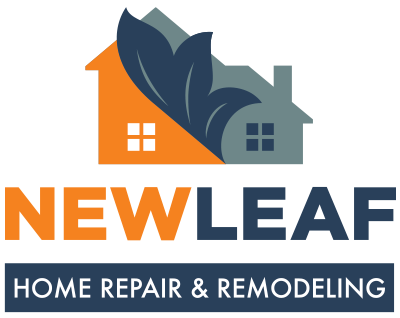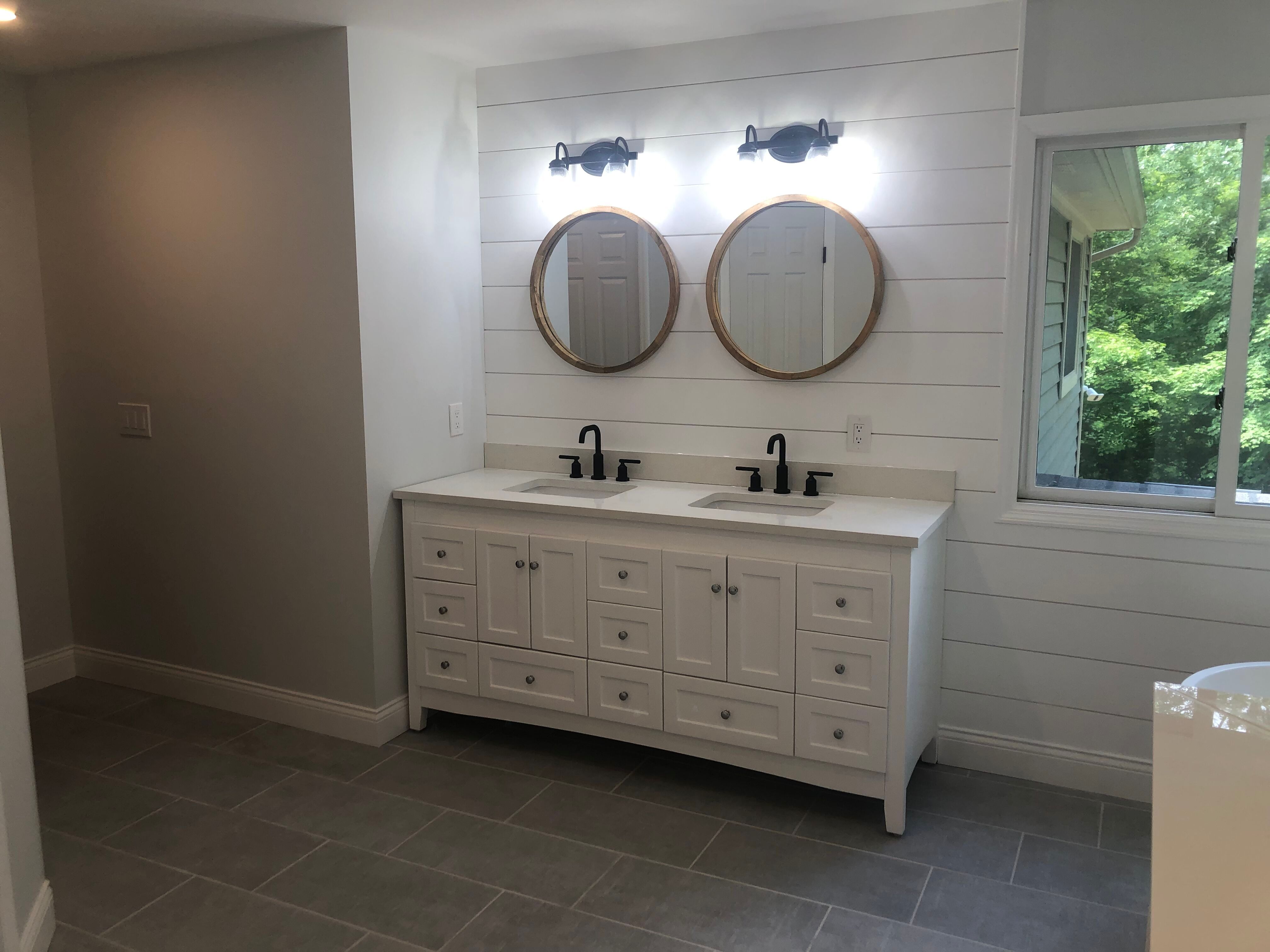Cost of Repairing and Remodeling a Home in Cincinnati in 2024
Here at New Leaf Home Repair and Remodeling, we like to provide as much value as possible and be as transparent about the process as possible.
Today you will learn everything that goes into the cost of creating a space you will love.
In our company, we have priced many jobs and know what it takes to get the job done.
Factors Affecting Cost
1. Size and scope of the project
Depending on the size of your home you can either expect to be on the higher or lower end of the following ranges. Remember that the size of your home affects the cost of various things, so it's important to keep this in mind when planning your expenses.
2. Materials and finishes
Choosing finishes can make or break your budget.
For example, a porcelain countertop may be trendy and look nice but, may be a bit more expensive than a laminate countertop.
3. Permits and regulations
When planning a remodeling project, it's important to remember that permits and regulations come with a cost.
We'll factor these costs into the final price ranges and averages so that you can get the full picture.
Average Costs of Common Remodeling Projects
| Job Type | Low-end Average | Middle-end Average | High-end Average |
|---|---|---|---|
| Kitchen Remodel | $15,000 (materials and labor included) | $70,000 (materials and labor included) | $150,000+ (materials and labor included) |
| Bathroom Remodel | $400/sqft (materials and labor included) | $375/sqft (materials and labor included) | $250/sqft (materials and labor included) |
| Basement Remodel | $50/sqft (materials and labor included) | $65/sqft (materials and labor included) | $80/sqft (materials and labor included) |
| Deck Remodel | $65/sqft (materials and labor included) | $55/sqft (materials and labor included) | $45/sqft (materials and labor included) |
| New Deck Build | |||
| Composite | $120/sqft (materials and labor included) | $100/sqft (materials and labor included) | $80/sqft (materials and labor included) |
| Treated | $90/sqft (materials and labor included) | $70/sqft (materials and labor included) | $50/sqft (materials and labor included) |
| Wall Additions and Removals | $7,000 (materials and labor included) | $11,000 (materials and labor included) | $15,000+ (materials and labor included) |
| Fireplace Remodel | $8,000 (materials and labor included) | $14,000 (materials and labor included) | $20,000+ (materials and labor included) |
| Home Addition | $325/sqft (materials and labor included) | $290/sqft (materials and labor included) | $260/sqft (materials and labor included) |
Average Costs of Common Repair Projects
| Job Type | Small Job | Medium Job | Large Job |
|---|---|---|---|
| Wood Rot Repair | $800 (materials and labor included) | $7,000 (materials and labor included) | $25,000+ (materials and labor included) |
| Soffit Repair | $850 (materials and labor included) | $2,000 (materials and labor included) | $5,000+ (materials and labor included) |
| Window Header Repair | $5000 (materials and labor included) | $7,500 (materials and labor included) | $10,000+ (materials and labor included) |
| Rake Board Repair | $1000 (materials and labor included) | $2,500 (materials and labor included) | $5,000+ (materials and labor included) |
| Wood Window Repair | $1500 (materials and labor included) | $3,500 (materials and labor included) | $8,000+ (materials and labor included) |
| Drywall Repair | $750 (materials and labor included) | $2,500 (materials and labor included) | $7,000+ (materials and labor included) |
7 Tips for Budgeting When Remodeling
- Set a Realistic Budget: Before starting any remodeling project, determine how much you can afford to spend. Consider your savings, available credit, and potential financing options. Be realistic about what you can comfortably afford without straining your finances.
- Prioritize Needs vs. Wants: Make a list of your remodeling priorities, distinguishing between essential upgrades and nice-to-have features. Focus your budget on addressing the most critical needs first before allocating funds to optional enhancements.
- Avoid Scope Creep: Define the scope of your remodeling project clearly from the outset and resist the temptation to make frequent changes or additions once work has begun. Each modification or expansion of the project can lead to additional costs in materials, labor, and time. Stick to your original plan as much as possible to prevent budget overruns.
- Plan for Contingencies: Anticipate unexpected expenses by setting aside a contingency fund. Generally, it's wise to allocate around 10-20% of your total budget for unforeseen costs, such as structural repairs, code compliance issues, or design changes.
- DIY vs. Hiring Professionals: Assess which aspects of the project you can handle yourself and which require professional expertise. While DIY can save money on labor costs, be realistic about your skills and the time commitment involved. Investing in experienced contractors may save you money by avoiding costly mistakes for complex or specialized tasks.
- Research Material Costs: Research the prices of materials needed for your remodeling project. Look for deals, discounts, or alternative options that can help you stay within budget without compromising quality. Remember that material prices can vary significantly depending on the supplier, brand, and quality.
- Track Expenses Closely: Throughout the remodeling process, keep detailed records of all expenses, including materials, labor, permits, and miscellaneous costs. Monitoring your spending closely allows you to stay on track with your budget and identify any areas where you may need to adjust or cut back to avoid overspending.
4 Possible Hidden Costs to Consider
- Unexpected Structural Issues: During the remodeling process, contractors may uncover structural problems that were not apparent during the initial assessment. This could include issues such as water damage, mold, termite infestations, or compromised foundations. Repairing these structural issues can be costly and may require additional time to address, potentially delaying the project's completion.
- Permit Fees and Inspections: Many remodeling projects require permits from local authorities to ensure compliance with building codes and regulations. Obtaining these permits incurs fees, which can vary depending on the scope and complexity of the project. Additionally, municipalities often require inspections at various stages of the remodeling process, which may incur additional fees if deficiencies are found and need rectification.
- Additional Repairs Uncovered During the Project: Contractors may discover hidden problems that require immediate attention once construction or demolition begins. This could include electrical or plumbing issues, outdated wiring, or inadequate insulation. Addressing these unforeseen repairs adds to the overall cost of the project and may necessitate adjustments to the original timeline.
- Contingency Fund for Unforeseen Expenses: Despite careful planning and budgeting, unexpected expenses can arise during the remodeling process. This could include material price increases, labor shortages, or changes in project scope. Setting aside a contingency fund, typically around 10-20% of the total project cost, helps buffer against these unforeseen expenses and ensures that the project can proceed smoothly without jeopardizing the budget. It provides peace of mind knowing there are funds available to address unexpected challenges without derailing the entire project.
Regional Variances in Costs
There are differences in cost across the United States of America. The main deciding factor is if you live in a big city prices go up.
New Leaf is based out of Cincinnati, Ohio. This is one of the more expensive cities in Ohio to live in as you can see here on this map.
Hiring the Right Professionals
- Researching and Vetting Contractors:
- Researching and vetting contractors is crucial to ensuring that you hire a reputable and competent professional for your remodeling project. Start by seeking recommendations from friends, family, or trusted sources in your community.
- Verify that the contractor is properly licensed, bonded, and insured to work in your area. This protects against liability for accidents or property damage that may occur during the project.
- Conduct background checks to assess the contractor's experience, qualifications, and track record. Look for evidence of successful projects similar in scope and complexity to yours.
- Interview multiple contractors to gauge their professionalism, communication skills, and compatibility with your project requirements. Ask probing questions about their approach to project management, subcontractor oversight, and conflict resolution.
- Checking References and Reviews:
- Request references from past clients and follow up with them to inquire about their experience working with the contractor. Ask about the quality of workmanship, adherence to budget and timelines, and overall satisfaction with the completed project.
- Online reviews and testimonials can also provide valuable insights into the contractor's reputation and performance. Check popular review platforms, such as Yelp, Google, or Angie's List, for feedback from previous customers.
- Pay attention to recurring themes or patterns in the reviews, both positive and negative, to get a comprehensive understanding of the contractor's strengths and weaknesses. Be wary of contractors with a high volume of negative reviews or unresolved complaints.
- Importance of Written Contracts and Timelines:
- A written contract is essential for establishing clear expectations and protecting both parties' interests throughout the remodeling process. The contract should outline the scope of work, project timeline, payment schedule, and any relevant terms and conditions.
- Ensure that the contract includes detailed specifications for materials, finishes, and project deliverables to avoid misunderstandings or disputes later on. Clearly define the responsibilities of the contractor and the homeowner to minimize the risk of miscommunication.
- Establishing a realistic timeline with milestones and deadlines helps keep the project on track and allows for effective project management. Include provisions in the contract for addressing delays, change orders, and unforeseen circumstances that may impact the schedule.
- Regular communication and progress updates between the contractor and homeowner are essential for maintaining transparency and accountability throughout the project. Address any concerns or deviations from the agreed-upon timeline promptly to prevent delays or cost
Conclusion
From considering factors such as the size and scope of the project to navigating permit fees and inspections, we have outlined key considerations that homeowners should keep in mind when budgeting for their remodeling projects. Additionally, we have provided tips for effectively managing expenses and avoiding common pitfalls, such as scope creep and hidden costs.
By researching and vetting contractors, checking references and reviews, and establishing clear written contracts and timelines, homeowners can mitigate risks and ensure that their remodeling projects are completed to their satisfaction. We understand the importance of communication, accountability, and professionalism in delivering high-quality results that exceed our clients' expectations.
As you embark on your remodeling journey, we encourage you to stay informed, ask questions, and make decisions that align with your vision and budget. With careful planning and the right team of professionals by your side, you can transform your home into a space that you truly love.
Thank you for considering New Leaf Home Repair and Remodeling for your remodeling needs. We look forward to the opportunity to work with you and bring your vision to life.


